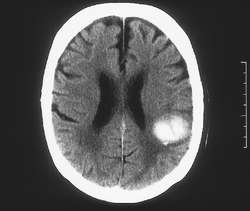Themes: Hyperacute Care, ICH, Causes

|
Martin is a 56 year old gentleman has had a moderate headache. He was FAST positive with right sided weakness his son called an ambulance. He is on warfrain as he has a metal aortic valve replacement. His Target INR is usually 3. BP today is now 147/100 mmHg. He has been brought in by paramedics. You attend the stroke call with the specialist nurse |
|---|
1. What is the most important test
A non-contrast CT is the most important initial test. He is on Warfarin which makes us concerned that the stroke is haemorrhagic. A CT Scan is the quickest and most reliable way to determine if there is Intracerebral haemorrhage.
3. What is the best test to measure the effect of Warfarin
The INR and in this case his INR is 6. An INR in someone not talking warfarin is 1.0 when treated it is usually between 2 and 3. Certainly 6 is too high and increases the risk of bleeding.
2. A CT scan is performed.

3. What does the scan show
A CT Scan confirms a haemorrhagic stroke.
His GCS is 14 and NIHSS is 12
4. What treatment is recommended
- Reverse the warfarin effect with IV Vitamin K and 4 factor PCC
- Neurosurgical referral would not intervene until clotting has been normalised.
- His risk of further bleeding in the short term outweighs the risk of reversing anticoagulation even with a metal valve
- A decision to restart anticoagulation in the days after a stroke must be made with cardiology and based on the position and type of valve
5. Looking at the CT what complications might occur
Bleeding into the ventricles always raises the risk of developing an obstructive hydrocephalus which would be treated with placement of an external ventricular drainage. If he was to have any further drop in GCS he would need a repeat CT and neurosurgical consult. Further and worsening haemorrhage can also occur.
| Note: The plan is to keep the website free through donations and advertisers that do not present any conflicts of interest. I am keen to advertise courses and conferences. If you have found the site useful or have any constructive comments please write to me at drokane (at) gmail.com. I keep a list of patrons to whom I am indebted who have contributed. If you would like to advertise a course or conference then please contact me directly for costs and to discuss a sponsored link from this site. |